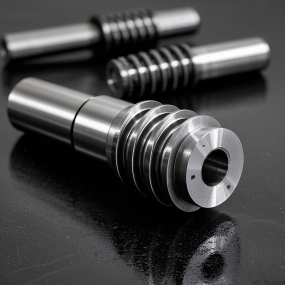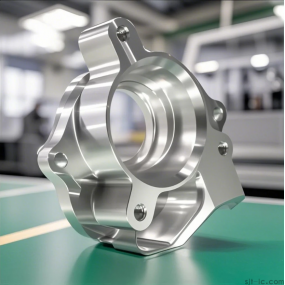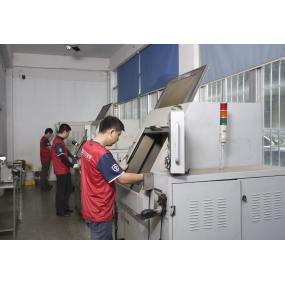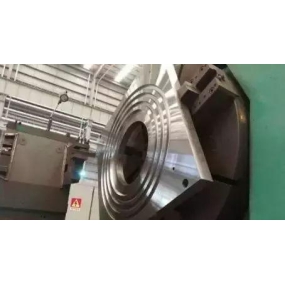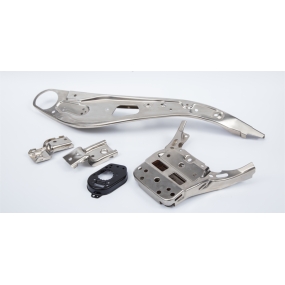CNC Machining center is a high-precision machining equipment that integrates automation, intelligence, composite machining, and high-speed processing. Among them, horizontal and vertical machining centers are currently the most widely used models. So what are the advantages and disadvantages of the structural characteristics and technical performance of the two? Below, Hongweisheng Precision Technology will provide you with a detailed explanation. Let's take a look together.
1、 Characteristics of Horizontal Machining Centers
A horizontal machining center is relative to a vertical machining center. Its spindle is a horizontal machining center, usually equipped with an automatic indexing rotary worktable. It generally has 3-5 motion coordinates, commonly three linear motion coordinates plus one rotary motion coordinate. After one clamping, the workpiece can complete the machining of the other four surfaces except for the installation surface and top surface. Nowadays, horizontal machining centers have five axis five linkage models, which can machine the other five surfaces except for the bottom surface, that is, the installation surface, at once.
Horizontal machining centers are most suitable for adding box type parts. Compared with vertical machining centers, horizontal machining centers have easier chip removal during machining, which is beneficial for machining. Due to the good structure of horizontal machining centers, they can process large and complex parts. It can be said that workpieces that cannot be machined by vertical machining centers can be machined on horizontal machining centers. But there are always advantages and disadvantages. Horizontal machining centers have the disadvantages of complex structure and higher price compared to vertical machining centers.
2、 Characteristics of Vertical Machining Centers
A vertical machining center refers to a machining center where the spindle is in a vertical state. Its structural form is mostly a fixed column, and the worktable is rectangular. Generally, ordinary models do not have indexing and rotation functions, and are suitable for machining disc, sleeve, and plate parts. It generally has three linear motion coordinate axes, and its X, Y, and Z axes are controlled by direct linkage. It is a semi closed loop vertical machining center, which has the advantages of large guide rail load, wide span, high accuracy, compact and reasonable structure and external dimensions. The spindle is driven by a servo motor through a synchronous belt, and can achieve one-time clamping of various disc, plate, shell, cam, mold and other complex parts. It can complete various processes such as drilling, milling, boring, expanding, hinge, rigid tapping, etc. Suitable for the production of multiple varieties and small to medium batch products, it can meet the processing of complex and high-precision parts. And a rotary table that rotates along the horizontal axis, commonly known as the fourth rotation axis, can be installed on the workbench to meet the processing requirements of special parts and spiral parts.
Vertical machining centers are easy to install, operate, observe machining conditions, and debug programs, making them widely used. However, this type of machine is limited by the height of the column and the tool changing device, and cannot process parts that are too high. When processing cavities or concave surfaces, chips are not easily discharged, and in severe cases, they can damage the tool, destroy the processed surface, and affect the smooth progress of processing. This can be solved by installing automatic chip conveyors and oil coolers.


 Spanish
Spanish Arabic
Arabic French
French Portuguese
Portuguese Belarusian
Belarusian Japanese
Japanese Russian
Russian Malay
Malay Icelandic
Icelandic Bulgarian
Bulgarian Azerbaijani
Azerbaijani Estonian
Estonian Irish
Irish Polish
Polish Persian
Persian Boolean
Boolean Danish
Danish German
German Filipino
Filipino Finnish
Finnish Korean
Korean Dutch
Dutch Galician
Galician Catalan
Catalan Czech
Czech Croatian
Croatian Latin
Latin Latvian
Latvian Romanian
Romanian Maltese
Maltese Macedonian
Macedonian Norwegian
Norwegian Swedish
Swedish Serbian
Serbian Slovak
Slovak Slovenian
Slovenian Swahili
Swahili Thai
Thai Turkish
Turkish Welsh
Welsh Urdu
Urdu Ukrainian
Ukrainian Greek
Greek Hungarian
Hungarian Italian
Italian Yiddish
Yiddish Indonesian
Indonesian Vietnamese
Vietnamese Haitian Creole
Haitian Creole Spanish Basque
Spanish Basque

